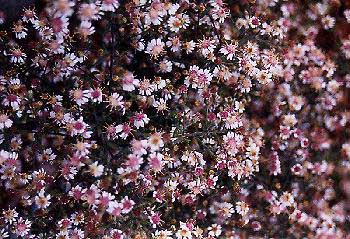Aster lateriflorus
Family: Asteraceae
Pronounced: ASS-ter lat-er-ih-FLOOR-us
Quick Jumps
Growing Guide
Rainy Side Notes
GROWING GUIDE

Geographical origin:
North America.
Plant group:
Perennial.
Hardiness:
Sunset zones: All (Western).
USDA zones: 4-8.
Mature size:
Height: 24 inches (60 cm).
Width: 12 inches (30 cm).
Flowering period:
Midsummer to mid-autumn.
Flowering attributes:
Small ½-inch white flowers with pink centers, born along one side of the stem.
Leaf attributes:
Tiny-toothed green leaves that turn coppery in the fall.
Growth habit:
Clump forming perennial.
Light:
Partial Shade.
Soil:
Moist, fertile soil.
Feeding:
Mulch with compost or composted manure in fall. Fertilize with a complete organic fertilizer in spring and again in early summer.
Propagation methods:
Sow seed in spring or fall at 68°F (20°C). | Divide plants in spring.
Pruning methods:
Cut back plants to half in early summer to promote bushiness. (I let the slugs do this for me.)
Pests and diseases:
Slugs and snails may eat young growth.
Rainy Side Notes
Aster lateriflorus is not difficult to start from seed. Start seed in autumn and over winter in pots in a cold frame or greenhouse, or sow in spring. This plant looks good in front of large, dark foliage to contrast with the small light flowers.
Although recommended for partial shade, here in the Pacific Northwest you can grow them in full sun. This aster tends to seed around like a weed, so if you do not want to be pulling this plant out, deadhead the spent flowers.
Grow this aster as a forage plant for the butterflies and bees.
Photographed in author's garden.

Gardening for the Homebrewer: Grow and Process Plants for Making Beer, Wine, Gruit, Cider, Perry, and More
By co-authors Debbie Teashon (Rainy Side Gardeners) and Wendy Tweton
Copyright Notice | Home | Search | Perennials

